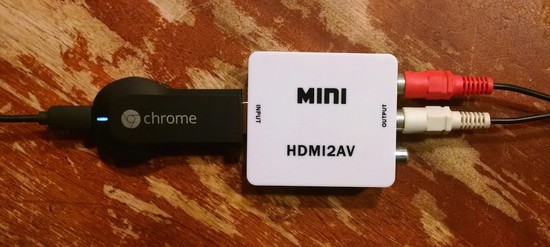DIY Audio Casting |
January 27th, 2015 |
| tech |
A ChromeCast basically does this, but its output is HDMI. Attached to a HDMI2AV converter box, it gives analog output suitable for the speakers I already have:

This works pretty well. The HDMI2AV box has a connector for external power and ships with a mini (not micro) USB cable, but I found that it was able to get enough power over HDMI from the ChromeCast. The main downside is that the output from the converter is very high. I needed to turn my speakers way down, and the feature of the speakers where they go into standby on low input didn't work. Putting an old analog mixer set to low volume between the converter and the speaker fixed this: volume levels were reasonable and standby worked. I may replace the mixer with a resistor, but I'm pretty happy with it all as it is now.
(Usage: in Play Music on the phone, choose the Cast icon and select the name of the ChromeCast. Now audio comes out of the good speaker instead of the impressive-for-its-size-but-still-tiny phone speaker.)
Update 2015-02-09: It turns out that leaving this on all the time doesn't work. The HDMI2AV gets out of sync with the ChromeCast and starts sending bursts of static through the speaker. As long as we turn the speaker off when we're not using it this isn't a problem, but it's kind of annoying.)
Comment via: google plus, facebook, substack